Performance Assessment of Oil-Immersed Cellulose Insulator Materials Using Time–Domain Spectroscopy under Varying Temperature and Humidity Conditions
Abstract
1. Introduction
2. The Theoretical Analysis of Power Series
3. The Preparation and Testing Process of Oil-Immersed Cellulose Pressboards
4. The Novel Method for Calculating the PTC Data at Various Temperatures
4.1. The Feature Parameters Extraction on the PTC Data Based on the Power Series Theory
4.2. Research on Temperature Conversion Method.
5. Verification Experiments in the Laboratory
6. Conclusions
- A functional model based on the power series theory is applied to fitting the PTC curve of oil-immersed cellulose pressboards. A sixth-order power function model is used by including the proper fitting accuracy and overfitting prophylactic measure. The average value of goodness-of-fit measure exceeding 0.99, which indicates that the sixth-order power series model can be used to describe the PTC curve accurately;
- The coefficient θj (i = 0, 1, ..., 6) used in the sixth power series model is related to both the moisture inside the oil-immersed cellulose and the test temperature. The mathematical model among the normalized parameters (τj) of coefficient θj, the moisture inside the oil-immersed cellulose and the test temperature can be established by depth fitting technique;
- Relying on the computed parameters τj(mc%, T) and θj-tes by using the mentioned mathematical model and Equation (14), the PTC curve at any temperature can be calculated by the sixth-order power series model and the conversion of PTC curve between different temperatures is thus realized;
- Findings reveal that the obtained relative error of the temperature correction is less than 20%, which proves the feasibility of the proposed method. In particular, the proposed model outperforms the “master curve” technique which does not take into account the effects of moisture content;
- This work provides a novel method to correct the temperature effect on the PTC data, which is expected to promote the evaluation of aging or wetness of transformer cellulose insulating material.
Author Contributions
Funding
Conflicts of Interest
References
- N’Cho, J.S.; Fofana, I.; Hadjadj, Y.; Beroual, A. Review of Physicochemical-Based Diagnostic Techniques for Assessing Insulation Condition in Aged Transformers. Energies 2016, 9, 367. [Google Scholar] [CrossRef]
- Alsuhaibani, S.; Khan, Y.; Beroual, A.; Malik, N.H. A Review of Frequency Response Analysis Methods for Power Transformer Diagnostics. Energies 2016, 9, 879. [Google Scholar] [CrossRef]
- Linhjell, D.; Lundgaard, L.; Gafvert, U. Dielectric response of mineral oil impregnated cellulose and the impact of aging. IEEE Trans. Dielectr. Electr. Insul. 2007, 14, 156–169. [Google Scholar] [CrossRef]
- Liu, J.; Fan, X.; Zhang, Y.; Zhang, C.; Wang, Z. Aging evaluation and moisture prediction of oil-immersed cellulose insulation in field transformer using frequency domain spectroscopy and aging kinetics model. Cellulose 2020, 27, 7175–7189. [Google Scholar] [CrossRef]
- Emsley, A.; Stevens, G. Review of chemical indicators of degradation of cellulosic electrical paper insulation in oil-filled transformers. IEE Proc. Sci. Meas. Technol. 1994, 141, 324–334. [Google Scholar] [CrossRef]
- Liu, J.F.; Fan, X.H.; Zhang, C.H.; Lai, C.S.; Zhang, Y.Y.; Zheng, H.B.; Lai, L.L.; Zhang, E.Z. Moisture diagnosis of transformer oil-immersed insulation with intelligent technique and frequency-domain spectroscopy. IEEE Trans. Ind. Inform. 2020. [Google Scholar] [CrossRef]
- Sun, W.; Yang, L.; Zare, F.; Lin, Y.; Cheng, Z. Improved method for aging assessment of winding hot-spot insulation of transformer based on the 2-FAL concentration in oil. Int. J. Electr. Power Energy Syst. 2019, 112, 191–198. [Google Scholar] [CrossRef]
- Lundgaard, L.E.; Hansen, W.; Ingebrigtsen, S. Ageing of Mineral Oil Impregnated Cellulose by Acid Catalysis. IEEE Trans. Dielectr. Electr. Insul. 2008, 15, 540–546. [Google Scholar] [CrossRef]
- Jiang, J.; Zhao, M.; Zhang, C.; Chen, M.; Liu, H.; Albarracín-Sánchez, R. Partial Discharge Analysis in High-Frequency Transformer Based on High-Frequency Current Transducer. Energies 2018, 11, 1997. [Google Scholar] [CrossRef]
- Siegel, M.; Coenen, S.; Beltle, M.; Tenbohlen, S.; Weber, M.; Fehlmann, P.; Hoek, S.M.; Kempf, U.; Schwarz, R.; Linn, T.; et al. Calibration Proposal for UHF Partial Discharge Measurements at Power Transformers. Energies 2019, 12, 3058. [Google Scholar] [CrossRef]
- Patsch, R. Return Voltage Measurements—A Promising Tool for the Diagnosis of the Insulation Condition of Power Transformers. In Proceedings of the 2018 IEEE International Conference on High Voltage Engineering and Application (ICHVE), Athens, Greece, 10–13 September 2018. [Google Scholar]
- Yang, F.; Du, L.; Yang, L.; Wei, C.; Wang, Y.; Ran, L.; He, P. A Parameterization Approach for the Dielectric Response Model of Oil Paper Insulation Using FDS Measurements. Energies 2018, 11, 622. [Google Scholar] [CrossRef]
- Zhang, D.; Yun, H.; Zhan, J.; Sun, X.; He, W.; Niu, C.; Mu, H.; Zhang, G.-J. Insulation condition diagnosis of oil-immersed paper insulation based on non-linear frequency-domain dielectric response. IEEE Trans. Dielectr. Electr. Insul. 2018, 25, 1980–1988. [Google Scholar] [CrossRef]
- Saha, T.K.; Purkait, P. Investigation of polarization and depolarization current measurements for the assessment of oil-paper insulation of aged transformers. IEEE Trans. Dielectr. Electr. Insul. 2004, 11, 144–154. [Google Scholar] [CrossRef]
- Wei, J.-L.; Zhang, G.-J.; Xu, H.; Peng, H.-D.; Wang, S.-Q.; Dong, M. Novel characteristic parameters for oil-paper insulation assessment from differential time-domain spectroscopy based on polarization and depolarization current measurement. IEEE Trans. Dielectr. Electr. Insul. 2011, 18, 1918–1928. [Google Scholar] [CrossRef]
- Saha, T.K. Review of time-domain polarization measurements for assessing insulation condition in aged transformers. IEEE Trans. Power Deliv. 2003, 18, 1293–1301. [Google Scholar] [CrossRef]
- Setayeshmehr, A.; Fofana, I.; Borsi, H.; Gockenbach, E.; Eichler, C.; Akbari, A. Dielectric spectroscopic measurements on transformer oil-paper insulation under controlled laboratory conditions. IEEE Trans. Dielectr. Electr. Insul. 2008, 15, 1100–1111. [Google Scholar] [CrossRef]
- Hao, J.; Liao, R.; Chen, G.; Ma, Z.; Yang, L. Quantitative analysis ageing status of natural ester-paper insulation and mineral oil-paper insulation by polarization/depolarization current. IEEE Trans. Dielectr. Electr. Insul. 2012, 19, 188–199. [Google Scholar] [CrossRef]
- Saha, T.K.; Purkait, P. Investigations of temperature effects on the dielectric response measurements of transformer oil-paper insulation system. IEEE Trans. Power Deliv. 2008, 23, 252–260. [Google Scholar] [CrossRef]
- Saha, T.K.; Purkait, P. Understanding the impacts of moisture and thermal ageing on transformer’s insulation by dielectric response and molecular weight measurements. IEEE Trans. Dielectr. Electr. Insul. 2008, 15, 568–582. [Google Scholar] [CrossRef]
- Liu, J.; Fan, X.; Zhang, Y.; Zheng, H.; Jiao, J. Temperature correction to dielectric modulus and activation energy prediction of oil-immersed cellulose insulation. IEEE Trans. Dielectr. Electr. Insul. 2020, 27, 956–963. [Google Scholar] [CrossRef]
- Liu, J.; Fan, X.; Zhang, Y.; Zheng, H.; Zhang, C. Condition prediction for oil-immersed cellulose insulation in field transformer using fitting fingerprint database. IEEE Trans. Dielectr. Electr. Insul. 2020, 27, 279–287. [Google Scholar] [CrossRef]
- Fofana, I.; Hemmatjou, H.; Farzaneh, M. Low temperature and moisture effects on polarization and depolarization currents of oil-paper insulation. Electr. Power Syst. Res. 2010, 80, 91–97. [Google Scholar] [CrossRef]
- Fofana, I.; Hemmatjou, H.; Meghnefi, F. Effect of thermal transient on the polarization and depolarization current measurements. IEEE Trans. Dielectr. Electr. Insul. 2011, 18, 513–520. [Google Scholar] [CrossRef]
- Ma, Z.; Liao, R.; Zhao, X.; Wang, Y.; Yang, L. Influence of temperature on polarization and depolarization current of oil-paper insulation. Trans. China Electrotech. Soc. 2012, 29, 426–430. [Google Scholar] [CrossRef]
- Zheng, H.B.; Lai, B.H.; Zhang, Y.Y.; Liu, J.F.; Yang, S.C. Correction for Polarization Current Curve of Polymer Insulation Materials in Transformers Considering the Temperature and Moisture Effects. Polymers 2020, 12, 143. [Google Scholar] [CrossRef]
- Mishra, D.; Baral, A.; Chakravorti, S. De-noising of time-domain spectroscopy data for reliable assessment of power transformer insulation. IET Gener. Transm. Distrib. 2020, 14, 1500–1507. [Google Scholar] [CrossRef]
- Liu, J.F.; Fan, X.H.; Zhang, Y.Y.; Li, S. Frequency Domain Spectroscopy Prediction of Transformer Oil-Immersed Cellulose Insulation under Diverse Temperature and Moisture. IEEE Trans. Dielectr Electr Insul. 2020. [Google Scholar] [CrossRef]
- Zupan, T.; Mikulecky, A.; Ziger, I. Ageing, Temperature and Water Content Influence on Oil-Paper Insulation: Model Preparation. In Proceedings of the IEEE International Conference on Dielectrics (ICD), Budapest, Hungary, 1–5 July 2018; Volume 1, pp. 1–4. [Google Scholar]
- Baral, A.; Chakravorti, S. A modified Maxwell model for characterization of relaxation processes within insulation system having non-uniform aging due to temperature gradient. IEEE Trans. Dielectr. Electr. Insul. 2013, 20, 524–534. [Google Scholar] [CrossRef]
- Odibat, Z.; Shawagfeh, N. Generalized Taylor’s formula. Appl. Math. Comput. 2007, 186, 286–293. [Google Scholar] [CrossRef]
- Liu, J.; Fan, X.; Zhang, Y.; Zheng, H.; Zhu, M. Quantitative evaluation for moisture content of cellulose insulation material in paper/oil system based on frequency dielectric modulus technique. Cellulose 2019, 27, 2343–2356. [Google Scholar] [CrossRef]
- Koch, M.; Kruger, M. A Fast and Reliable Dielectric Diagnostic Method to Determine Moisture in Power Transformers. In Proceedings of the International Conference on Condition Monitoring & Diagnosis, Beijing, China, 21–24 April 2008; pp. 467–470. [Google Scholar]
- International Electrotechnical Commission (IEC). IEC 60814:1997, Insulating Liquids—Oil-Impregnated Paper and Pressboard—Determination of Water by Automatic Coulometric Karl Fischer Titration; International Electrotechnical Commission (IEC): Geneva, Switzerland, 1997. [Google Scholar]
- Zhang, G.J. Experimental Research on Effects of Temperature and Aging State on Time Domain Dielectric Response Characteristics of Oil-impregnated Pressboard Insulation. Proc. CSEE 2012, 32, 69–75. [Google Scholar]

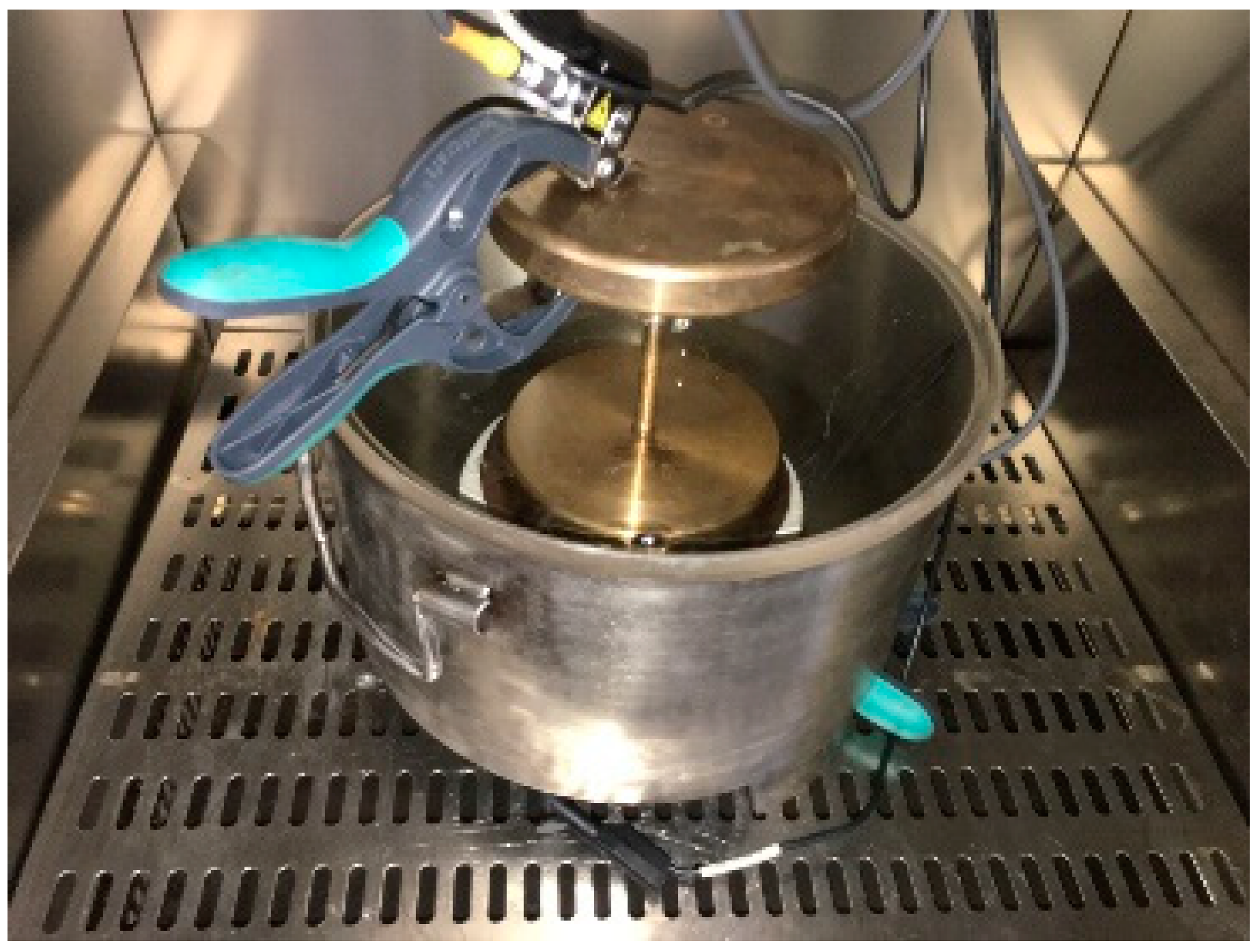
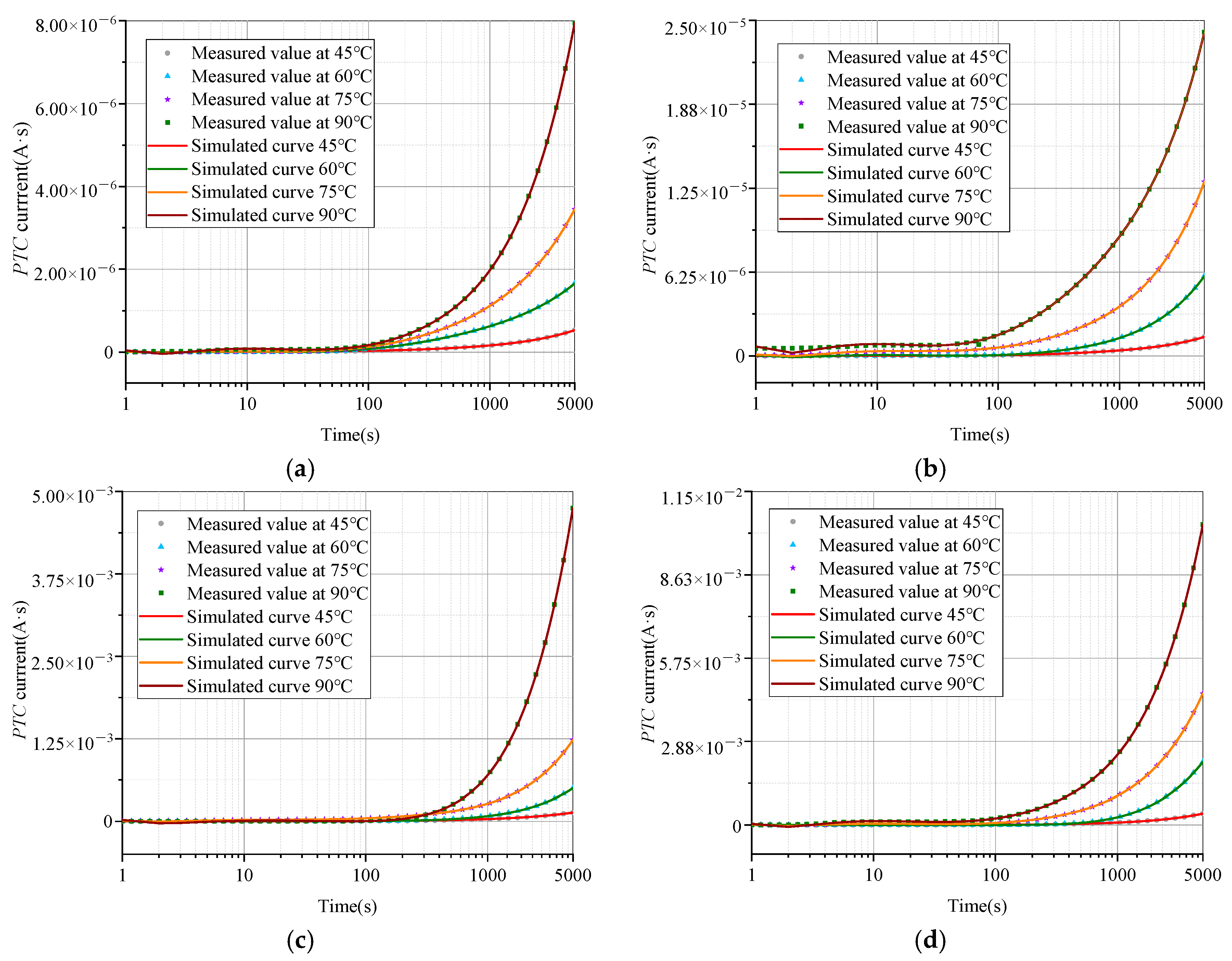
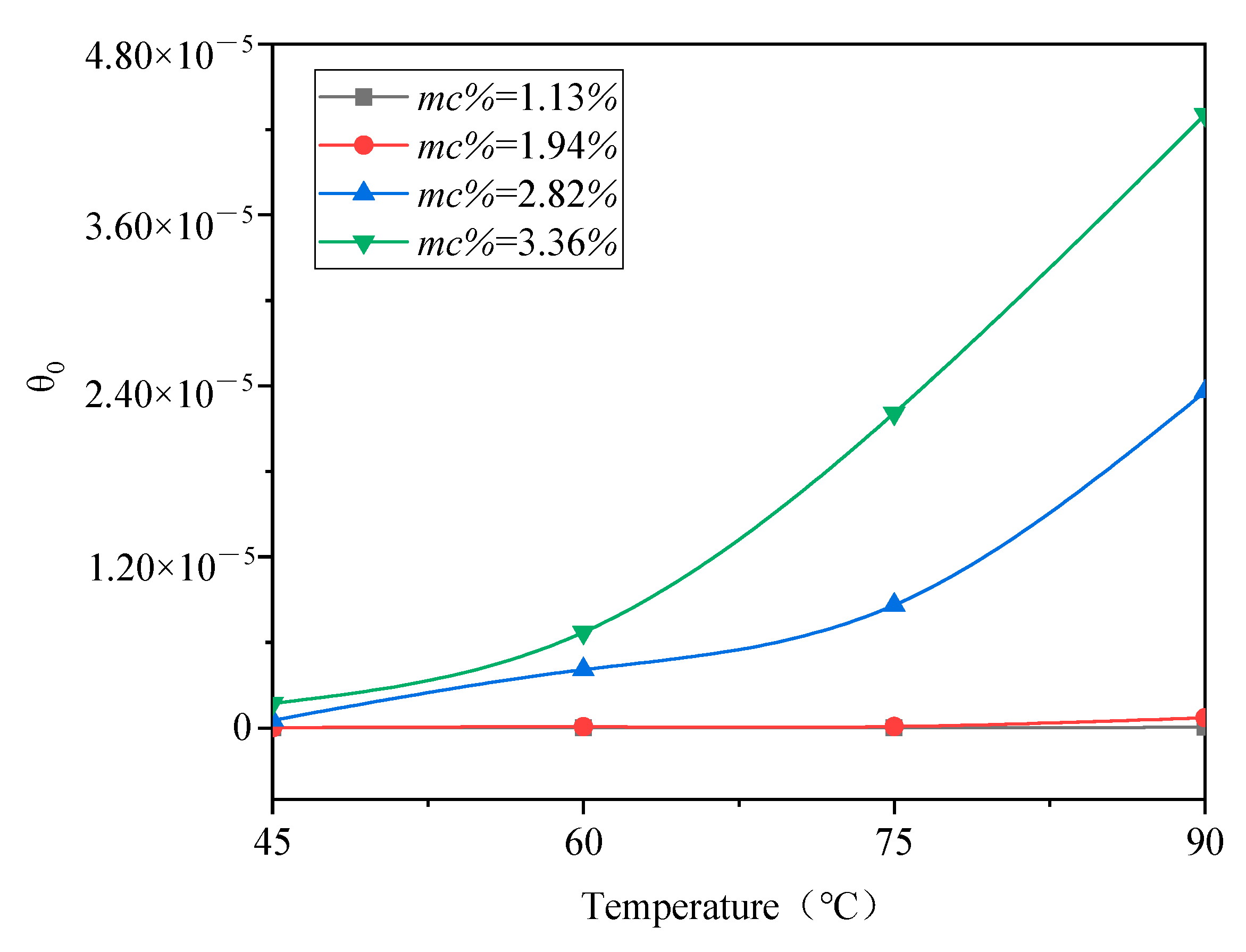
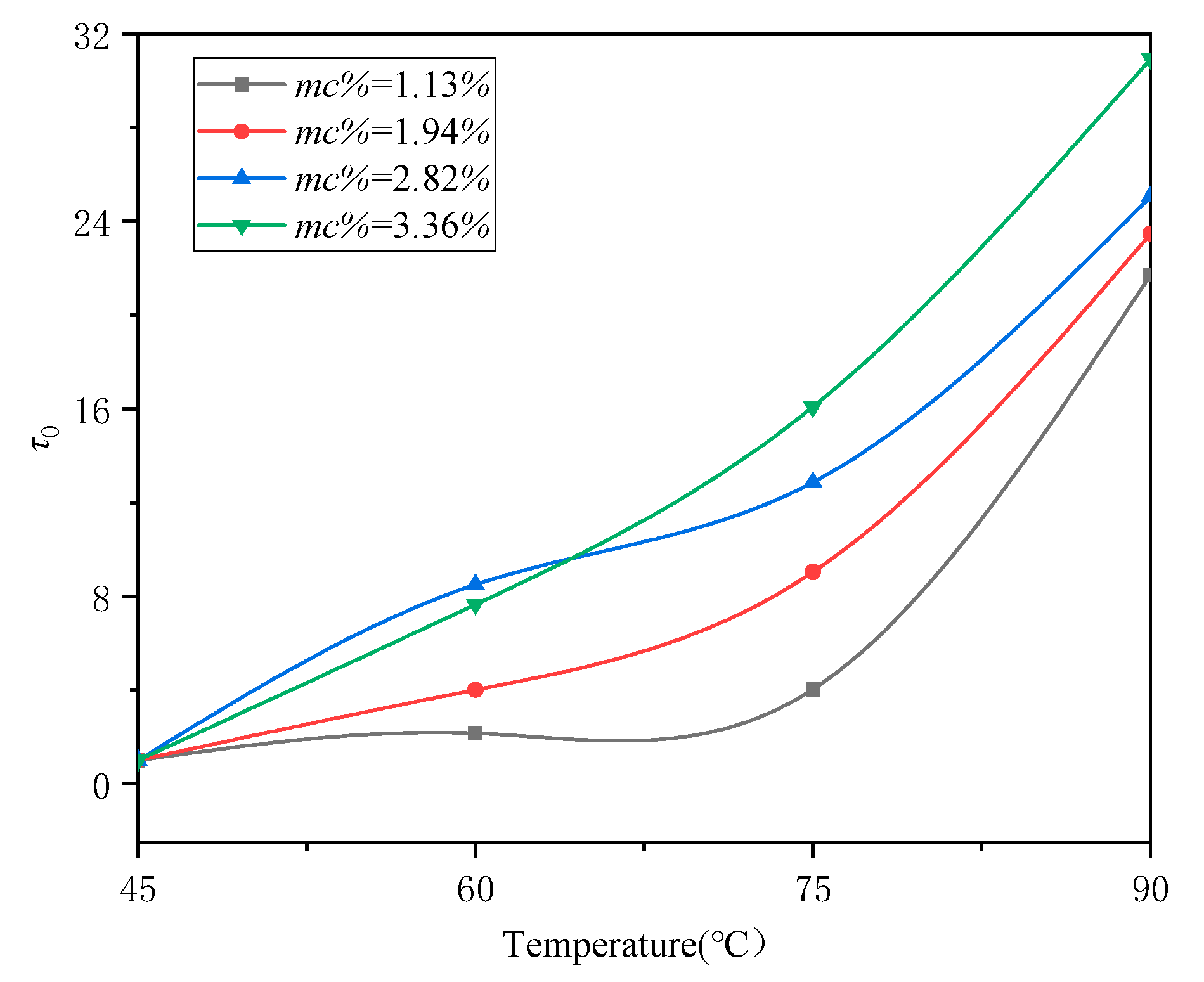

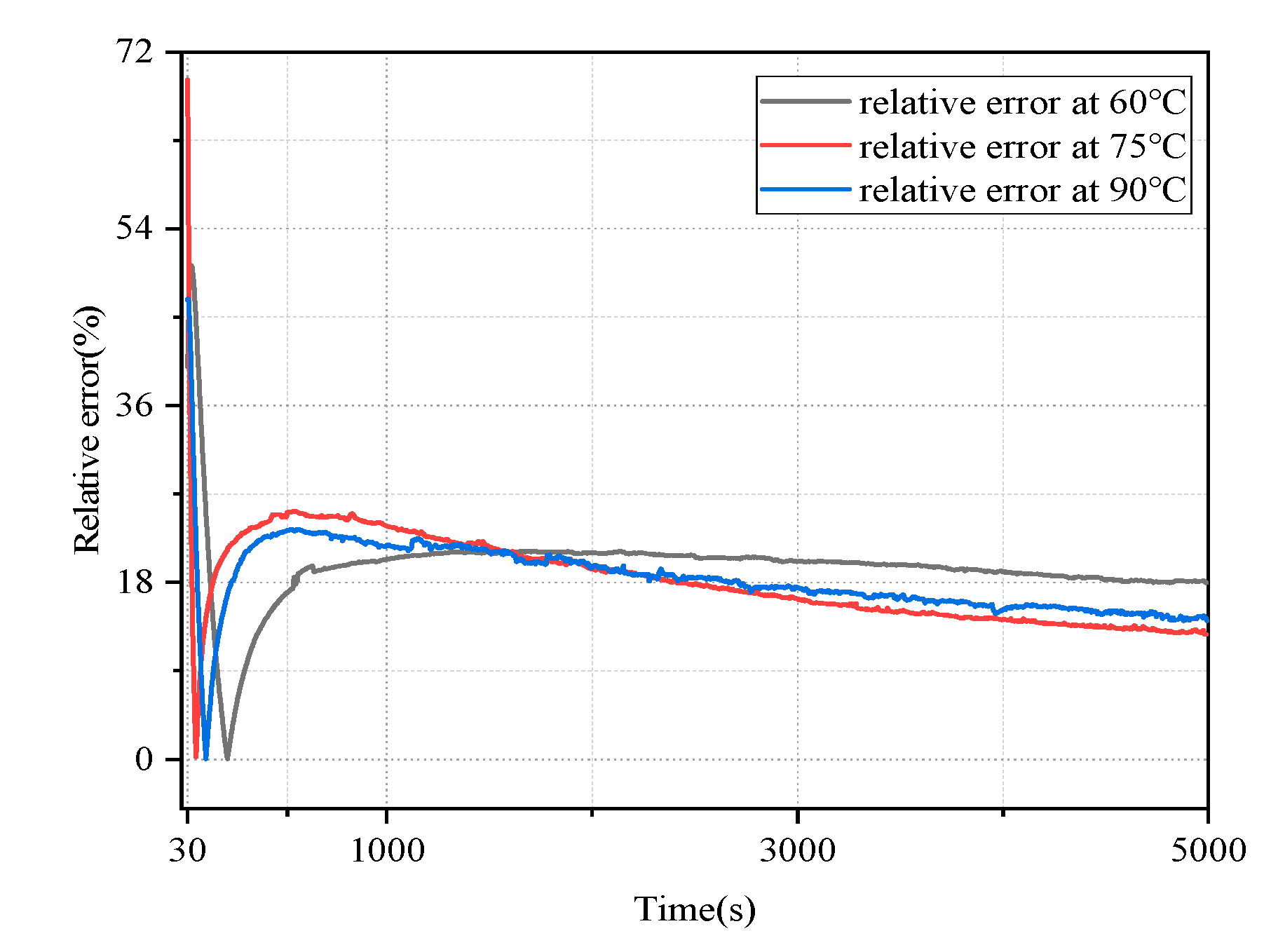

| Cellulous Pressboard | Insulating Oil | ||
|---|---|---|---|
| Brand | T4 pressboard | Brand | Karamay no. 25 mineral oil |
| Thickness | 0.5 mm | tan δ | 4 × 10−4 |
| Density | 0.96 g/cm3 | Pour point | ≤−45 °C |
| TS | MD: 98 MPa, CMD: 47 MPa | Flash point | 135 °C |
| j | 4 | 5 | 6 | 7 |
|---|---|---|---|---|
| Average R2 | 0.9752 | 0.9836 | 0.9950 | 0.9990 |
| Coefficient | 45 °C | 60 °C | 75 °C | 90 °C |
|---|---|---|---|---|
| θ0 | 1.816 × 10−9 | 3.926 × 10−9 | 7.323 × 10−9 | 3.941 × 10−8 |
| θ1 | −6.088 × 10−8 | −1.905 × 10−7 | −2.985 × 10−7 | −9.346 × 10−7 |
| θ2 | 2.098 × 10−7 | 6.798 × 10−7 | 1.059 × 10−6 | 3.101 × 10−6 |
| θ3 | −2.421 × 10−7 | −8.632 × 10−7 | −1.316 × 10−6 | −3.626 × 10−6 |
| θ4 | 1.315 × 10−7 | 4.842 × 10−7 | 7.305 × 10−7 | 1.944 × 10−6 |
| θ5 | −3.350 × 10−8 | −1.197 × 10−7 | −1.823 × 10−7 | −4.907 × 10−7 |
| θ6 | 3.402 × 10−9 | 1.133 × 10−8 | 1.801 × 10−8 | 5.011 × 10−8 |
| Normalized Parameter | mc% = 1.13% | Normalized Parameter | mc% = 1.94% | ||||||
|---|---|---|---|---|---|---|---|---|---|
| 45 | 60 | 75 | 90 | 45 | 60 | 75 | 90 | ||
| τ0(1.13, T) | 1.00 | 2.16 | 4.03 | 21.71 | τ0(1.94, T) | 1.00 | 4.01 | 9.04 | 23.48 |
| τ1(1.13, T) | 1.00 | 3.13 | 4.90 | 15.35 | τ1(1.94, T) | 1.00 | 3.93 | 5.43 | 16.60 |
| τ2(1.13, T) | 1.00 | 3.24 | 5.05 | 14.78 | τ2(1.94, T) | 1.00 | 3.71 | 6.25 | 17.11 |
| τ3(1.13, T) | 1.00 | 3.57 | 5.44 | 14.98 | τ3(1.94, T) | 1.00 | 3.75 | 6.44 | 17.58 |
| τ4(1.13, T) | 1.00 | 3.68 | 5.56 | 14.78 | τ4(1.94, T) | 1.00 | 3.80 | 6.55 | 17.75 |
| τ5(1.13, T) | 1.00 | 3.57 | 5.44 | 14.65 | τ5(1.94, T) | 1.00 | 3.72 | 6.69 | 17.53 |
| τ6(1.13, T) | 1.00 | 3.33 | 5.29 | 14.73 | τ6(1.94, T) | 1.00 | 3.88 | 6.93 | 17.01 |
| Normalized Parameter | mc% = 2.28% | Normalized Parameter | mc% = 3.36% | ||||||
|---|---|---|---|---|---|---|---|---|---|
| 45 | 60 | 75 | 90 | 45 | 60 | 75 | 90 | ||
| τ0(2.28, T) | 1.00 | 8.50 | 12.817 | 25.07 | τ0(3.36, T) | 1.00 | 7.65 | 16.09 | 30.94 |
| τ1(2.28, T) | 1.00 | 5.11 | 9.28 | 21.46 | τ1(3.36, T) | 1.00 | 5.65 | 11.82 | 25.79 |
| τ2(2.28, T) | 1.00 | 4.63 | 8.74 | 21.54 | τ2(3.36, T) | 1.00 | 4.97 | 11.88 | 34.70 |
| τ3(2.28, T) | 1.00 | 4.32 | 8.60 | 21.72 | τ3(3.36, T) | 1.00 | 4.75 | 11.94 | 31.89 |
| τ4(2.28, T) | 1.00 | 4.06 | 8.47 | 21.71 | τ4(3.36, T) | 1.00 | 4.67 | 12.13 | 30.65 |
| τ5(2.28, T) | 1.00 | 4.05 | 8.35 | 21.55 | τ5(3.36, T) | 1.00 | 4.79 | 12.52 | 31.69 |
| τ6(2.28, T) | 1.00 | 4.30 | 8.47 | 21.56 | τ6(3.36, T) | 1.00 | 4.95 | 12.75 | 30.73 |
| τ0(mc%, T) = (Z0 + Z1 × x + Z2 × y + Z3 × y2 + Z4 × x × y)/(1 + Z5 × x + Z6 × y + Z7 × x2 + Z8 × y2 + Z9 × x × y) | |||||
| Z0 | −27.913 | Z4 | −9.697 | Z8 | 0.023 |
| Z1 | 439.417 | Z5 | 11.631 | Z9 | −0.461 |
| Z2 | −6.778 | Z6 | −1.769 | Precision | 10−15 |
| Z3 | 0.143 | Z7 | 3.443 | R-square | 0.981 |
| τ1(mc%, T) = (Z0 + Z1 × x + Z2 × y + Z3 × y2 + Z4 × x × y)/(1 + Z5 × x + Z6 × y + Z7 × x2 + Z8 × y2 + Z9 × x × y) | |||||
| Z0 | 106.976 | Z4 | −2.179 | Z8 | 0.010 |
| Z1 | 102.418 | Z5 | −0.412 | Z9 | −0.097 |
| Z2 | −5.820 | Z6 | −0.822 | Precision | 10−15 |
| Z3 | 0.062 | Z7 | 1.306 | R-square | 0.986 |
| τ2(mc%, T) = (Z0 + Z1 × x + Z2 × y + Z3 × y2 + Z4 × x × y)/(1 + Z5 × x + Z6 × y + Z7 × x2 + Z8 × y2 + Z9 × x × y) | |||||
| Z0 | 300.999 | Z4 | −4.186 | Z8 | 0.015 |
| Z1 | 186.128 | Z5 | −26.097 | Z9 | 0.022 |
| Z2 | −13.769 | Z6 | −1.166 | Precision | 10−15 |
| Z3 | 0.134 | Z7 | 4.419 | R-square | 0.998 |
| τ3(mc%, T) = (Z0 + Z1 × x + Z2 × y + Z3 × y2 + Z4 × x × y)/(1 + Z5 × x + Z6 × y + Z7 × x2 + Z8 × y2 + Z9 × x × y) | |||||
| Z0 | 63.104 | Z4 | −2.233 | Z8 | 0.007 |
| Z1 | 102.893 | Z5 | −12.176 | Z9 | 0.022 |
| Z2 | −3.988 | Z6 | −0.577 | Precision | 10−15 |
| Z3 | 0.042 | Z7 | 1.791 | R-square | 0.996 |
| τ4(mc%, T) = (Z0 + Z1 × x + Z2 × y + Z3 × y2 + Z4 × x × y)/(1 + Z5 × x + Z6 × y + Z7 × x2 + Z8 × y2 + Z9 × x × y) | |||||
| Z0 | 1.707 | Z4 | −1.121 × 105 | Z8 | −1.796 × 107 |
| Z1 | 1.531 × 108 | Z5 | 4.741 × 108 | Z9 | 9.063 × 104 |
| Z2 | −9.448 × 108 | Z6 | 3.469 × 107 | Precision | 10−15 |
| Z3 | 1.735 × 107 | Z7 | −2.017 × 108 | R-square | 0.994 |
| τ5(mc%, T) = (Z0+ Z1 × x + Z2 × y + Z3 × y2 + Z4 × y3)/(1 + Z5 × x + Z6 × x2 + Z7 × x3 + Z8 × y + Z9 × y2) | |||||
| Z0 | 1729.159 | Z4 | −0.011 | Z8 | −0.642 |
| Z1 | 13.202 | Z5 | −17.428 | Z9 | 0.002 |
| Z2 | −94.237 | Z6 | 13.771 | Precision | 10−15 |
| Z3 | 1.690 | Z7 | −2.067 | R-square | 0.991 |
| τ6(mc%, T) = (Z0 + Z1 × x + Z2 × y + Z3 × y2 + Z4 × x × y)/(1 + Z5 × x + Z6 × y + Z7 × x2 + Z8 × y2 + Z9 × x × y) | |||||
| Z0 | 8.690 × 109 | Z4 | −5.492 × 108 | Z8 | 1.190 × 106 |
| Z1 | 2.465 × 1010 | Z5 | −3.370 × 109 | Z9 | 6.167 × 106 |
| Z2 | −7.284 × 108 | Z6 | −8.614 × 107 | Precision | 10−15 |
| Z3 | 9.238 × 106 | Z7 | 4.837 × 108 | R-square | 0.996 |
| τ0(mc%, T) | mc% = 1.51% | ||
|---|---|---|---|
| 60 °C | 75 °C | 90 °C | |
| τ0(1.51, T) | 3.58 | 6.08 | 20.65 |
| τ1(1.51, T) | 3.32 | 5.53 | 15.94 |
| τ2(1.51, T) | 3.32 | 5.85 | 15.04 |
| τ3(1.51, T) | 3.08 | 6.21 | 15.54 |
| τ4(1.51, T) | 3.36 | 6.26 | 15.81 |
| τ5(1.51, T) | 2.86 | 6.35 | 15.57 |
| τ6(1.51, T) | 3.31 | 6.20 | 15.37 |
| RMSE | 60 °C | 75 °C | 90 °C |
|---|---|---|---|
| PTC | 0.32 | 0.37 | 0.31 |
© 2020 by the authors. Licensee MDPI, Basel, Switzerland. This article is an open access article distributed under the terms and conditions of the Creative Commons Attribution (CC BY) license (http://creativecommons.org/licenses/by/4.0/).
Share and Cite
Lai, B.; Yang, S.; Zhang, H.; Zhang, Y.; Fan, X.; Liu, J. Performance Assessment of Oil-Immersed Cellulose Insulator Materials Using Time–Domain Spectroscopy under Varying Temperature and Humidity Conditions. Energies 2020, 13, 4426. https://doi.org/10.3390/en13174426
Lai B, Yang S, Zhang H, Zhang Y, Fan X, Liu J. Performance Assessment of Oil-Immersed Cellulose Insulator Materials Using Time–Domain Spectroscopy under Varying Temperature and Humidity Conditions. Energies. 2020; 13(17):4426. https://doi.org/10.3390/en13174426
Chicago/Turabian StyleLai, Benhui, Shichang Yang, Heng Zhang, Yiyi Zhang, Xianhao Fan, and Jiefeng Liu. 2020. "Performance Assessment of Oil-Immersed Cellulose Insulator Materials Using Time–Domain Spectroscopy under Varying Temperature and Humidity Conditions" Energies 13, no. 17: 4426. https://doi.org/10.3390/en13174426
APA StyleLai, B., Yang, S., Zhang, H., Zhang, Y., Fan, X., & Liu, J. (2020). Performance Assessment of Oil-Immersed Cellulose Insulator Materials Using Time–Domain Spectroscopy under Varying Temperature and Humidity Conditions. Energies, 13(17), 4426. https://doi.org/10.3390/en13174426








